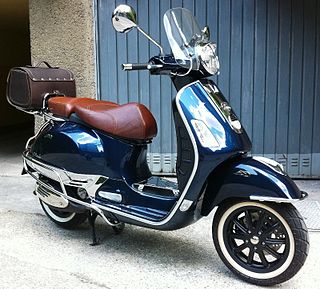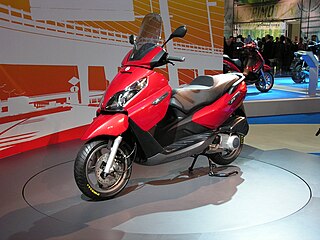
Vespa is an Italian luxury brand of scooters and mopeds manufactured by Piaggio. The name means wasp in Italian. The Vespa has evolved from a single model motor scooter manufactured in 1946 by Piaggio & Co. S.p.A. of Pontedera, Italy to a full line of scooters and one of seven companies today owned by Piaggio.

Malaguti is an Italian bicycle, scooter and motorcycle company based in San Lazzaro di Savena, founded by Antonino Malaguti in 1930. Producing bicycles until 1958, they then entered the motorcycle market. Noted for their use of small engines in their bikes. In October 2011, Malaguti laid off its remaining employees in Bologna, Italy as the company eventually folded.

The Honda Pantheon is a scooter, manufactured by Honda in the Italian factories of Honda Italia Industriale S.p.A in Atessa.

The Porsche 911 GT3 is a high-performance homologation model of the Porsche 911 sports car. It is a line of high-performance models, which began with the 1973 911 Carrera RS. The GT3 has had a successful racing career in the one-make national and regional Porsche Carrera Cup and GT3 Cup Challenge series, as well as the international Porsche Supercup supporting the FIA Formula 1 World Championship.

The Piaggio MP3 is a tilting three-wheeled scooter by Italian manufacturer Piaggio. First marketed in 2006, it is noted for its combination of two front wheels and a single rear wheel.

The Piaggio Liberty is a two-wheeled scooter from the Italian manufacturer Piaggio.

The Vespa GTS range is a scooter currently manufactured by Piaggio under the Vespa brand.

The Vespa 946 is a scooter announced by Piaggio, to be sold under their Vespa brand starting in July 2013. Piaggio presented the retro-futurist Vespa Quarantasei concept, based on the 1945 Vespa MP6 prototype, at the 2011 EICMA motorcycle show. The final production version, renamed the Vespa 946, appeared the following year, at EICMA 2012. The 946 will be fitted with Piaggio’s new air-cooled, three-valve, single-cylinder engine, with a claimed output of 11.7 hp (8.7 kW) for the 125 cc (7.6 cu in) displacement version, and 13 hp (9.7 kW) for the 150 cc (9.2 cu in) version.

The MV Agusta 150 Sport RS was a motorcycle produced by the Italian motorcycle MV Agusta in their Cascina Costa plant from 1959 to 1969.

The Piaggio X7 is a scooter model produced by the Italian motorcycle manufacturer Piaggio.

Gilera Nexus is a maxi-scooter manufactured by Italian company Piaggio under the Gilera brand. Sold from 2003. It is available in four engines.

The Malaguti Madison is a scooter produced by the Malaguti motorcycle manufacturer in four generations: the first three from 1999 to 2011 at the historic Malaguti factory in Castel San Pietro Terme and the fourth from 2019 is produced in China by Zongshen-Piaggio joint venture.
The Malaguti Centro is an Italian-made motor cycle, produced by the motorcycle manufacturer Malaguti in two generations: the first from 1992 to 2001 and the second from 2007 to 2011.

The Malaguti Password is a scooter produced by Malaguti from 2005 to 2011 at the historic Malaguti factory in Castel San Pietro Terme.

The Malaguti Ciak is a scooter produced by Malaguti from 1999 to 2011 at the historic Malaguti factory in Castel San Pietro Terme.

The Piaggio Fly is a scooter produced by italian motorcycle manufacturer Piaggio from 2004 to 2017 to replace the Sfera and Skipper models.

The Piaggio Free is a scooter produced by italian motorcycle manufacturer Piaggio from 1992 to 2002 in Pontedera.

The Kymco People is a two-wheeled scooter from the Taiwanese manufacturer Kymco.

The Aprilia SR GT is a two-wheeled scooter from the italian manufacturer Aprilia.

The Peugeot Streetzone is a scooter produced since 2013 by Peugeot Motocycles. An electric version, named the Peugeot e-Streetzone, was unveiled at the 2022 Paris Motor Show and will be available from 2023 with one or two batteries and a maximum range of 112 km (70 mi).



















